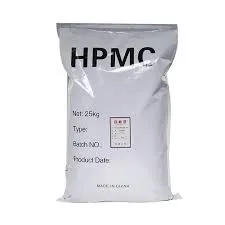
Nov . 11, 2024 03:41 Back to list
Investigation of HPMC Solubility Levels in Cold Water Solutions
HPMC Solubility in Cold Water An Overview
Hydroxypropyl methylcellulose (HPMC) is a cellulose derivative that has garnered significant attention in various industries, particularly in pharmaceuticals, food, and construction. Recognized for its versatile properties, HPMC is a popular choice among formulators seeking to enhance product performance across diverse applications. One of the critical characteristics that dictate the usability of HPMC is its solubility in cold water.
Understanding HPMC
HPMC is synthesized through the modification of cellulose, where hydroxyl and methoxy groups are introduced. This alteration not only improves the chemical stability of cellulose but also enhances its functionality. HPMC is known for its thickening, binding, film-forming, and stabilizing properties, making it an essential ingredient in many formulations.
Solubility in Cold Water
HPMC’s solubility in cold water is a significant factor that influences its application. Unlike many other cellulose derivatives, HPMC forms a clear, viscous solution when dispersed in cold water. This property is particularly advantageous because it allows for the formulation of products without the need for heating, which can sometimes alter the integrity or functionality of sensitive ingredients.
The solubility of HPMC in cold water is affected by several factors, including the degree of substitution and molecular weight. Higher levels of hydroxypropyl groups increase the solubility in water, as these modifications enhance the hydrophilic characteristics of the polymer. Generally, HPMC with a low molecular weight and high hydroxypropyl content dissolves more readily in cold water compared to its counterparts.
Applications of HPMC in Cold Water Soluble Formulations
hpmc solubility in cold water

1. Pharmaceuticals HPMC is widely used in the pharmaceutical industry as an excipient in tablet formulations. Its ability to form a gel-like matrix in cold water enhances the controlled release of active ingredients. Additionally, HPMC is employed in preparing hydrophilic film coatings that protect drugs from environmental factors.
2. Food Industry In the food sector, HPMC serves as a thickening and binding agent. It enhances texture and consistency in various products, such as sauces and dressings, without impacting the flavor profile. Its solubility in cold water allows for easy incorporation into cold food systems, thereby improving product stability and shelf life.
3. Construction HPMC is also used in construction materials, particularly in cementitious and dry-mix applications. Its solubility in cold water enables better workability and improves the adhesion and performance of mortars and tile adhesives. It helps retain moisture during the curing process, which is crucial for achieving desired strength in building materials.
Challenges and Considerations
While HPMC has several beneficial properties, there are challenges associated with its use, particularly regarding its solubilization in cold water. Poor dispersion can lead to clumping, which may affect the final viscosity and texture of the product. Therefore, it is essential to follow best practices during the mixing process. Incorporating the powder slowly into water while stirring can help achieve a uniform solution and minimize the formation of lumps.
Moreover, it is crucial to select the appropriate grade of HPMC based on the specific application requirements. Different grades have varied characteristics in terms of viscosity, gel strength, and behavior in cold water. Careful consideration of these properties during formulation will lead to better product stability and performance.
Conclusion
HPMC's solubility in cold water is a vital property that enhances its applicability across various industries. Understanding the factors influencing this solubility, including degree of substitution and molecular weight, allows formulators to tailor their products effectively. Whether used in pharmaceuticals, food, or construction, HPMC continues to be a valuable ingredient that provides significant benefits when utilized correctly. As research and development in this area progress, innovations regarding HPMC applications will likely expand, reaffirming its relevance in contemporary formulations.
-
Versatile Hpmc Uses in Different Industries
NewsJun.19,2025
-
Redispersible Powder's Role in Enhancing Durability of Construction Products
NewsJun.19,2025
-
Hydroxyethyl Cellulose Applications Driving Green Industrial Processes
NewsJun.19,2025
-
Exploring Different Redispersible Polymer Powder
NewsJun.19,2025
-
Choosing the Right Mortar Bonding Agent
NewsJun.19,2025
-
Applications and Significance of China Hpmc in Modern Industries
NewsJun.19,2025







